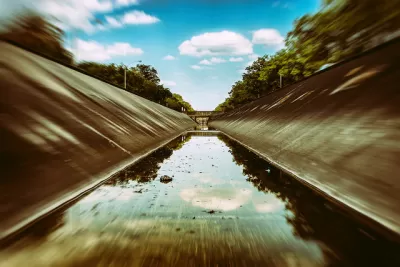A review of the current research into the effectiveness of green streets and green infrastructure finds gaps in our understanding of what works, and where.

"Surprisingly, there are very few peer-reviewed research papers that have evaluated Green Streets on a stormwater control and treatment basis," according to an article by Jonathan Page, who looks at some of the existing data and also makes recommendations for tailoring green streets to the specific needs of the natural and built characteristics of different cities.
According to Page, the “newness” of the green streets movement and the difficulty in monitoring and instrumenting green street projects contribute to a lack of data and research about the effectiveness of green streets.
Projects in Seattle and Portland have provided some non-peer reviewed dataset, "but the study and evaluation is typically not as rigorous as those found in a peer-reviewed journal."
Moreover, the "excellent" results in downstream water quality protection and combined sewer overflow (CSO) reductions from those examples can't be expected in all parts of the country (or world), according to Page. Portland, Seattle, and other communities in the Pacific Northwest are perfect locations for green streets because "[r]ainfall patterns and storms in that ecoregion are characterized by low rainfall intensities and long durations." In other ecoregions, like the Southeast, "storms tend to have a much higher rainfall intensity and shorter duration, which means a lot of above ground storage is needed to temporarily retain runoff for infiltration and treatment after the storm has passed."
FULL STORY: Do Green Streets Actually Work for Stormwater Management?

Planetizen Federal Action Tracker
A weekly monitor of how Trump’s orders and actions are impacting planners and planning in America.

San Francisco's School District Spent $105M To Build Affordable Housing for Teachers — And That's Just the Beginning
SFUSD joins a growing list of school districts using their land holdings to address housing affordability challenges faced by their own employees.

The Tiny, Adorable $7,000 Car Turning Japan Onto EVs
The single seat Mibot charges from a regular plug as quickly as an iPad, and is about half the price of an average EV.

Seattle's Plan for Adopting Driverless Cars
Equity, safety, accessibility and affordability are front of mind as the city prepares for robotaxis and other autonomous vehicles.

As Trump Phases Out FEMA, Is It Time to Flee the Floodplains?
With less federal funding available for disaster relief efforts, the need to relocate at-risk communities is more urgent than ever.

With Protected Lanes, 460% More People Commute by Bike
For those needing more ammo, more data proving what we already knew is here.
Urban Design for Planners 1: Software Tools
This six-course series explores essential urban design concepts using open source software and equips planners with the tools they need to participate fully in the urban design process.
Planning for Universal Design
Learn the tools for implementing Universal Design in planning regulations.
Smith Gee Studio
City of Charlotte
City of Camden Redevelopment Agency
City of Astoria
Transportation Research & Education Center (TREC) at Portland State University
US High Speed Rail Association
City of Camden Redevelopment Agency
Municipality of Princeton (NJ)





























